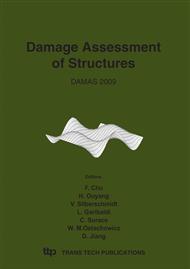p.211
p.219
p.229
p.237
p.245
p.253
p.261
p.269
p.277
Enhanced Assessment of the Remaining Service Life of a Steel Railway Bridge
Abstract:
During annual inspections of one of Sweden’s most important railway bridges, the Söderström Bridge in central Stockholm, cracks in the web of the main steel beams have been discovered. Extensive theoretical work has been undertaken to assess the remaining service life of the bridge. Furthermore, the bridge has recently been instrumented to enhance the theoretical predictions by monitoring the real railway traffic as well as the response of the bridge. This article describes the monitoring program and the analysis methods used. Some interesting results regarding the remaining fatigue life are presented.
Info:
Periodical:
Pages:
245-252
Citation:
Online since:
June 2009
Authors:
Keywords:
Price:
Сopyright:
© 2009 Trans Tech Publications Ltd. All Rights Reserved
Share:
Citation:


